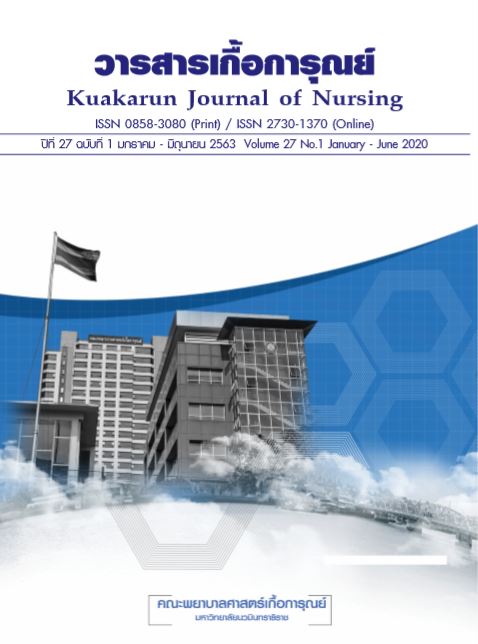การพัฒนาแนวปฏิบัติการจัดการความปวด ภาวะกระสับกระส่าย และภาวะสับสนเฉียบพลันในผู้ป่วยวิกฤตทางศัลยกรรม
คำสำคัญ:
แนวปฏิบัติทางคลินิก, การจัดการความปวด, ภาวะกระสับกระส่าย, ภาวะสับสนเฉียบพลัน, ผู้ป่วยวิกฤตทางศัลยกรรมบทคัดย่อ
การวิจัยและพัฒนานี้มีวัตถุประสงค์เพื่อพัฒนาแนวปฏิบัติการจัดการความปวด ภาวะกระสับกระส่าย และภาวะสับสนเฉียบพลันในผู้ป่วยวิกฤตทางศัลยกรรม ร่วมกับศึกษาแนวโน้มความเป็นไปได้ที่จะนำแนว ปฏิบัติไปใช้ในหอผู้ป่วยวิกฤตทางศัลยกรรม คณะแพทยศาสตร์วชิรพยาบาล มหาวิทยาลัยนวมินทราธิราช โดยประยุกต์ใช้รูปแบบการพัฒนาแนวปฏิบัติตามหลักฐานเชิงประจักษ์ของซูคัพเป็นกรอบแนวคิด กลุ่มตัวอย่าง คือพยาบาลจำนวน 65 คน เลือกแบบจำเพาะเจาะจง และเอกสารจากการทบทวนวรรณกรรม เครื่องมือ ที่ใช้เก็บรวบรวมข้อมูลได้แก่ แบบสอบถามข้อมูลส่วนบุคคลของกลุ่มตัวอย่าง แบบสอบถามความเป็นไปได้ ของความคิดเห็นต่อการนำแนวปฏิบัติไปใช้ และคู่มือแนวปฏิบัติตรวจสอบความตรงเชิงเนื้อหาได้ค่าดัชนี ความตรงเชิงเนื้อหา เท่ากับ .98 วิเคราะห์ข้อมูลโดยใช้สถิติบรรยาย
ผลการศึกษาพบว่า แนวปฏิบัติการจัดการความปวด ภาวะกระสับกระส่าย และภาวะสับสนเฉียบพลัน ในผู้ป่วยวิกฤตทางศัลยกรรม มีสาระสำคัญแบ่งเป็น 3 ส่วน คือ (1) การจัดการความปวดใน ผู้ป่วยวิกฤตทางศัลยกรรม ประกอบด้วย การประเมินความปวด การบรรเทาความปวด การประเมิน ความปวดซ้ำและการติดตามต่อเนื่อง และการบันทึกการจัดการความปวด (2) การจัดการภาวะกระสับกระส่าย ในผู้ป่วยวิกฤตทางศัลยกรรม และ (3) การจัดการภาวะสับสนเฉียบพลันในผู้ป่วยวิกฤตทางศัลยกรรม โดยพยาบาลส่วนใหญ่มากกว่าร้อยละ 90 ให้ความคิดเห็นว่าแนวปฏิบัตินี้มีความเป็นไปได้ในการนำไปใช้จัดการ ความปวด ภาวะกระสับกระส่ายและภาวะสับสนเฉียบพลันในผู้ป่วยวิกฤตทางศัลยกรรม
เอกสารอ้างอิง
Asadi-Noghabi A, Gholizadeh M, Zolfaghari M, Mehran A, Sohrabi M. Nurses use of critical care pain observational tool in patients with low consciousness. Oman Medical Journal 2015;30(4):276-82.
Alikiaie B, Mousavi S, Ebrahimi A, Foroughi Z. Evaluation of pain assessment and management in critically ill intubated patients in a referral university hospital in Iran. Journal of Pharmacy Practice and Research 2019;8(3):137-42.
Burk RS, Grap MJ, Munro CL, Schubert CM, Sessler CN. Agitation onset, frequency, and associated temporal factors in the adult critically ill. American Journal of Critical Care 2014;23(4):296-304.
Bigatello LM, Amirfarzan H, Haghighi AK, Newhouse B, Rio MD, Allen K, et al. Effects of routine monitoring of delirium in a surgical/trauma intensive care unit. Journal of Trauma Acute Care Surgery 2013;74(3):876-83.
Saengchote W. Sedation in critically ill patients: weighing risks and benefits. In: Staworn D, Piyavechviratana K, Poonyathawon S, editors. The Thai Society of Critical Care Medicine: the acute care. Bangkok: Beyond Enterprise; 2015. p. 458-62. (in Thai)
Jayaswal AK, Sampath H, Soohinda G, Dutta S. Delirium in medical intensive care units: Incidence, subtypes, risk factors, and outcome. Indian Journal of Psychiatry 2019;61(4):352-8.
Jovanovic G, Jakovljevic DK, Lukic-Sarkanovic M. Enhanced recovery in surgical intensive care: a review. Frontiers in Medicine 2018;5(256):1-6.
Faculty of Medicine Vajira Hospital, Navamindradhiraj University. Annual report 2015: acute pain management. Bangkok: Navamindradhiraj University; 2015. (in Thai)
Barr J, Fraser GL, Puntillo K, Ely EW, Gelinas C, Dasta JF, et al. Clinical practice guidelines for the management of pain, agitation, and delirium in adult patients in the intensive care unit. Critical Care Medicine 2013;41(1):263-306.
Mansouri P, Javadpour S, Zand F, Ghodsbin F, Sabetian G, Masjedi M, et al. Implementation of a protocol for integrated management of pain, agitation, and delirium can improve clinical outcomes in the intensive care unit: a randomized clinical trial. Journal of Critical Care 2013;28(6):918-22.
Reade MC, Finfer S. Sedation and delirium in the intensive care unit. The New England Journal of Medicine 2014;370(5):444-54.
Soukup M. The center of advanced nursing practice evidence-based practice model. Nursing Clinic of North America 2000;35:301-9.
Polit DF, Beck CT, Hungler BP. Essentials of nursing research (method, appraisal, and utilization). Philadelphia: Lippincott Williams & Wilkins; 2001. p. 429-56.
The Royal College of Physicians of Thailand. Recommendations for development of clinical practice guidelines. The Royal College of Physicians of Thailand 2001;18(6):36-47. (in Thai)
The Royal College of Anesthesiologists of Thailand, Thai Association for the Study of Pain. Clinical guidance for management of acute postoperative pain management. Bangkok: The Royal College; 2011. (in Thai)
Registered Nurses’ Association of Ontario. Clinical best practice guidelines: assessment andmanagement of pain [Internet]. 2013[cited 2020 Mar 5 ]. Available from: https://rnao.ca/sites/rnao-ca/files/AssessAndManagementOfPain2014.pdf
Punyodyan S. Effectiveness of implementing clinical practice guidelines for pain management among critically ill patients in surgical intensive care unit. Thai Journal of Nursing Council 2011;26(4):82-95. (in Thai)
Lukaszewicz AC, Dereu D, Gayat E, Payen D. The relevance of pupil-lometry for evaluation of analgesia before noxious procedures in the intensive care unit. Anesthesia & Analgesia 2015;120(6):1297-300.
Schug SA, Palmer GM, Scott DA, Halliwel R, Trienca J. A cute pain management: scientific evidence [Internet]. 2015 [cited 2020 Apr 5]. Available from: http://fpm.anzca.edu.au/documents/apmse4_2015_final
Morad A, Winters B, Stevens R, White E, Weingart J, Yaster M, et al. The efficacy of intravenous patient-controlled analgesia after intracranial surgery of the posterior fossa: a prospective, randomized controlled trial. Anesthesia & Analgesia 2012;114(2):416-23.
Stasevic K, Stasevic M, Jankovic S, Djukict DS, Dutina A, Grbic I. The validation and inter-rater reliability of the Serbian translation of the Richmond Agitation and Sedation Scale in post anesthesia care unit patients. Hippokratia 2016;20(1):50-4.
Shahabi M, Yousefi H, Yazdannik AR, Alikiaii B. The effect of daily sedation interruption protocol on early incidence of ventilator-associated pneumonia among patients hospitalized in critical care units receiving mechanical ventilation. Iranian Journal of Nursing and Midwifery Research 2016;21(5):541-6.
Dale CR, Bryson CL, Fan VS, Maynard C, Yanez ND, Treggiari MM. A greater analgesia, sedation, delirium order set quality score is associated with a decreased duration of mechanical ventila-tion in cardiovascular surgery patients. Critical Care Medicine 2013;41(11):2610-7.
Ngamkham S, Khiewchaum R, Boonlue O. The naive nurses knowledge and attitude regarding pain. Journal of Phrapokklao Nursing College 2014;25(2):65-72. (in Thai)
Ngamkham S, Krutchan N, Sawangchai J, Wattanakul B, Chidnayee K, Kiewcha-um R. Knowledge about pain assessment and management of Thai nurses. Journal of Nursing and Health Care 2018;36(1):81-9. (in Thai)
Gosselt AN, Slooter AJ, Boere PR, Zaal IJ. Risk factors for delirium after on-pump cardiac surgery: a systematic review. Critical Care 2015;19(1):346.















